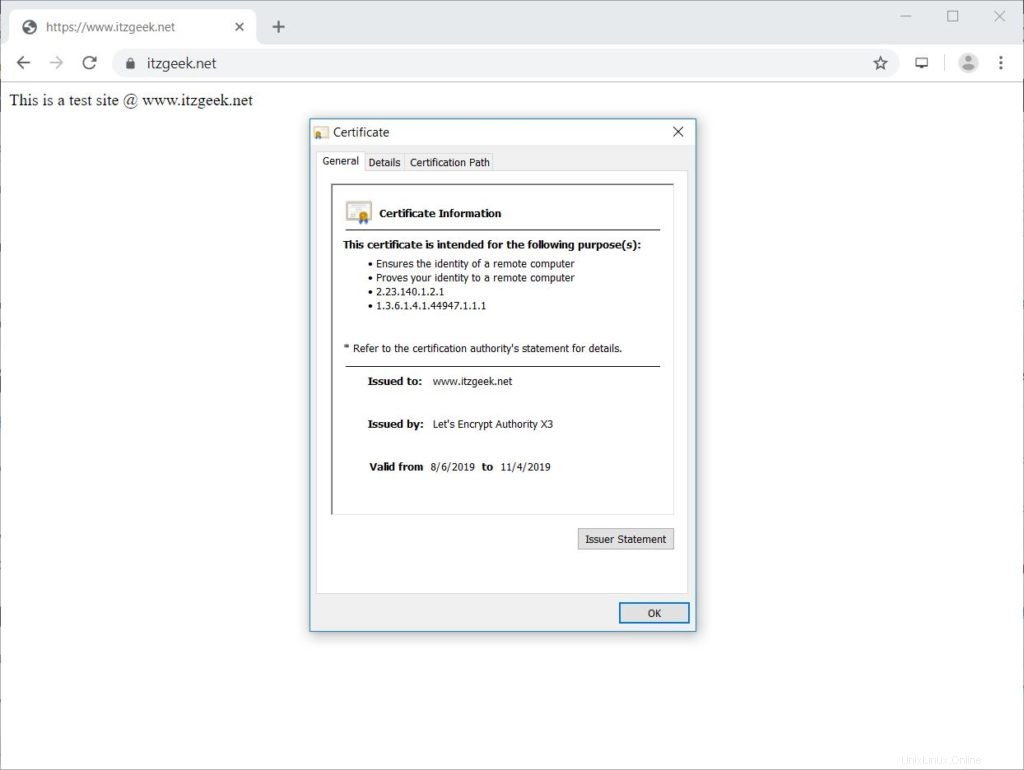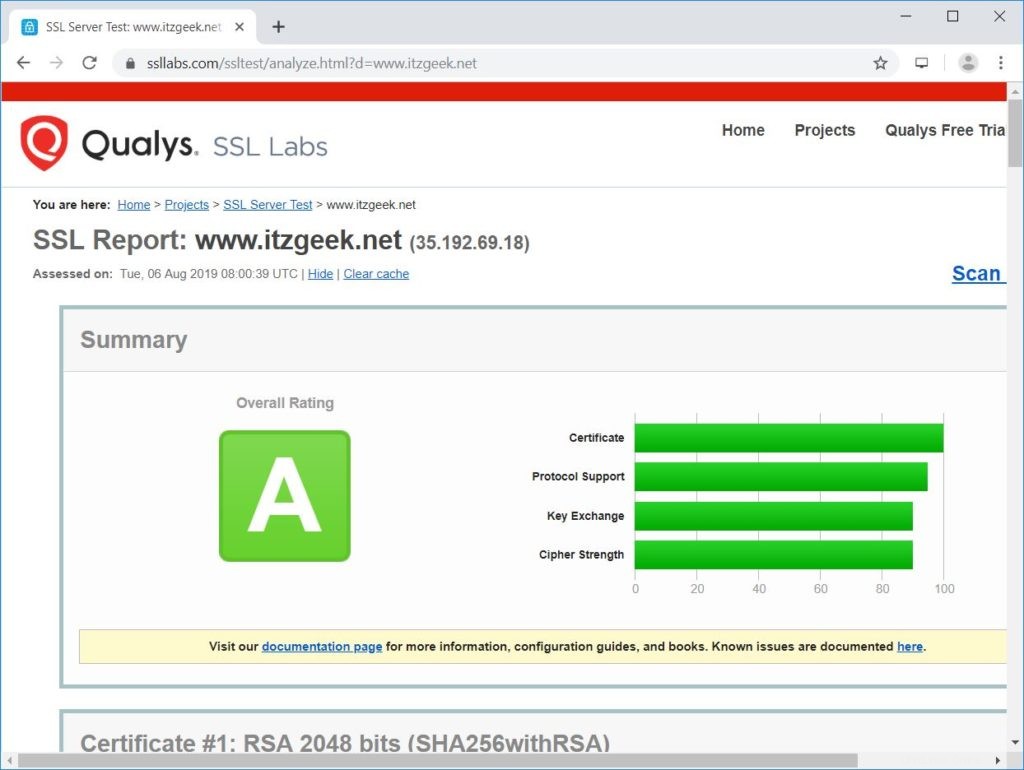Let's Encrypt es una autoridad de certificación ampliamente conocida que proporciona certificados SSL X.509 gratuitos para el cifrado TLS. Fue lanzado en abril de 2016.
Let's Encrypt automatiza el proceso de creación, validación, firma, implementación y renovación de certificados.
Actualmente, Apache, Nginx, Plex y Haproxy son compatibles con el proceso automatizado.
Requisitos
Antes de continuar, configure la pila LEMP para tener Nginx en su sistema Ubuntu.
LEER :Cómo instalar LEMP Stack en Ubuntu 18.04
LEER :Cómo instalar LEMP Stack en Ubuntu 16.04
Instalar Certbot
Para generar un certificado para su dominio, debe tener acceso a terminal/shell y cliente Certbot ACME. Maneja la emisión e instalación de certificados sin tiempo de inactividad.
Para instalar el cliente Certbot, debemos configurar Certbot PPA en Ubuntu.
sudo apt update sudo apt install -y software-properties-common sudo add-apt-repository universe sudo add-apt-repository ppa:certbot/certbot sudo apt update
Ahora, instale el cliente de certbot.
sudo apt install -y certbot python-certbot-nginx
Crear servidor virtual Nginx
Ahora crearemos un archivo de configuración de host virtual para el dominio www.itzgeek.net.
Este host virtual sirve la versión HTTP de su dominio.sudo nano /etc/nginx/conf.d/www.itzgeek.net.conf
Utilice la siguiente información.
server {
server_name www.itzgeek.net;
root /opt/nginx/www.itzgeek.net;
location / {
index index.html index.htm index.php;
}
access_log /var/log/nginx/www.itzgeek.net.access.log;
error_log /var/log/nginx/www.itzgeek.net.error.log;
location ~ \.php$ {
include /etc/nginx/fastcgi_params;
fastcgi_pass 127.0.0.1:9000;
fastcgi_index index.php;
fastcgi_param SCRIPT_FILENAME $document_root$fastcgi_script_name;
}
}
Cree una raíz de documento para almacenar sus archivos HTML.
sudo mkdir -p /opt/nginx/www.itzgeek.net
Cambia el permiso del directorio.
sudo chown -R nginx:nginx /opt/nginx/
Coloque el archivo HTML de prueba en la raíz del documento de su dominio.
echo "This is a test site @ www.itzgeek.net" | sudo tee /opt/nginx/www.itzgeek.net/index.html
Reinicie el servicio Nginx.
sudo systemctl restart nginx
Actualizar/Cambiar Registro DNS
Acceda a su herramienta de administración de DNS o registrador de dominios y cree un registro A/CNAME para el dominio. Ej:www.itzgeek.net.

Espere un tiempo para permitir que el registro se propague.
Compruebe la propagación de DNS con la utilidad Nslookup sudo apt install -y dnsutils.

Instalar el certificado SSL de Let's Encrypt
Use el comando certbot para crear un certificado de Let's Encrypt manualmente.
sudo certbot --nginx
Siga la indicación interactiva y genere el certificado requerido.
Saving debug log to /var/log/letsencrypt/letsencrypt.log Plugins selected: Authenticator nginx, Installer nginx Enter email address (used for urgent renewal and security notices) (Enter 'c' to cancel): [email protected] << Enter email address to receive notifications - - - - - - - - - - - - - - - - - - - - - - - - - - - - - - - - - - - - - - - - Please read the Terms of Service at https://letsencrypt.org/documents/LE-SA-v1.2-November-15-2017.pdf. You must agree in order to register with the ACME server at https://acme-v02.api.letsencrypt.org/directory - - - - - - - - - - - - - - - - - - - - - - - - - - - - - - - - - - - - - - - - (A)gree/(C)ancel: A << Agree to Terms of Service - - - - - - - - - - - - - - - - - - - - - - - - - - - - - - - - - - - - - - - - Would you be willing to share your email address with the Electronic Frontier Foundation, a founding partner of the Let's Encrypt project and the non-profit organization that develops Certbot? We'd like to send you email about our work encrypting the web, EFF news, campaigns, and ways to support digital freedom. - - - - - - - - - - - - - - - - - - - - - - - - - - - - - - - - - - - - - - - - (Y)es/(N)o: Y << Subscribe to Newsletter Which names would you like to activate HTTPS for? - - - - - - - - - - - - - - - - - - - - - - - - - - - - - - - - - - - - - - - - 1: www.itzgeek.net - - - - - - - - - - - - - - - - - - - - - - - - - - - - - - - - - - - - - - - - Select the appropriate numbers separated by commas and/or spaces, or leave input blank to select all options shown (Enter 'c' to cancel): 1 << Select domain to install Let's Encrypt SSL certificate Obtaining a new certificate Performing the following challenges: http-01 challenge for www.itzgeek.net Waiting for verification... Cleaning up challenges Deploying Certificate to VirtualHost /etc/nginx/conf.d/www.itzgeek.net.conf Please choose whether or not to redirect HTTP traffic to HTTPS, removing HTTP access. - - - - - - - - - - - - - - - - - - - - - - - - - - - - - - - - - - - - - - - - 1: No redirect - Make no further changes to the webserver configuration. 2: Redirect - Make all requests redirect to secure HTTPS access. Choose this for new sites, or if you're confident your site works on HTTPS. You can undo this change by editing your web server's configuration. - - - - - - - - - - - - - - - - - - - - - - - - - - - - - - - - - - - - - - - - Select the appropriate number [1-2] then [enter] (press 'c' to cancel): 2 << Redirect from HTTP to HTTPS Redirecting all traffic on port 80 to ssl in /etc/nginx/conf.d/www.itzgeek.net.conf - - - - - - - - - - - - - - - - - - - - - - - - - - - - - - - - - - - - - - - - Congratulations! You have successfully enabled https://www.itzgeek.net You should test your configuration at: https://www.ssllabs.com/ssltest/analyze.html?d=www.itzgeek.net - - - - - - - - - - - - - - - - - - - - - - - - - - - - - - - - - - - - - - - - IMPORTANT NOTES: - Congratulations! Your certificate and chain have been saved at: /etc/letsencrypt/live/www.itzgeek.net/fullchain.pem Your key file has been saved at: /etc/letsencrypt/live/www.itzgeek.net/privkey.pem Your cert will expire on 2019-11-04. To obtain a new or tweaked version of this certificate in the future, simply run certbot again with the "certonly" option. To non-interactively renew *all* of your certificates, run "certbot renew" - Your account credentials have been saved in your Certbot configuration directory at /etc/letsencrypt. You should make a secure backup of this folder now. This configuration directory will also contain certificates and private keys obtained by Certbot so making regular backups of this folder is ideal. - If you like Certbot, please consider supporting our work by: Donating to ISRG / Let's Encrypt: https://letsencrypt.org/donate Donating to EFF: https://eff.org/donate-le
Redirigir solicitudes HTTP que no sean www a www HTTPS con Nginx (opcional)
Ahora configuraremos el servidor Nginx para redirigir el tráfico que proviene del sitio HTTP que no es www al sitio WW HTTPS, es decir, http://itzgeek.net>> https://www.itzgeek.net .
Aquí, usaremos el mismo archivo de configuración que creamos para la versión HTTP del sitio para hacer la redirección del sitio HTTP que no es www a WW HTTPS.
sudo nano /etc/nginx/conf.d/www.itzgeek.net.conf
Agregue la siguiente información al final del archivo.
# Redirect NON-WWW HTTP to WWW HTTPS
server {
if ($host = itzgeek.net) {
return 301 https://www.itzgeek.net$request_uri;
}
server_name itzgeek.net;
listen 80;
return 404;
}
Reinicie el servicio Nginx.
sudo systemctl restart nginx
Verificar el certificado SSL de Let's Encrypt
Verifique el certificado de Let's Encrypt visitando la versión HTTPS de su sitio web.
http://tu-http-sitio-webO
https://tu-https-sitio-webDebería obtener la versión HTTPS de su sitio ahora.

Probar el certificado SSL de Let's Encrypt
Pruebe su certificado SSL en busca de problemas y sus clasificaciones de seguridad yendo a la siguiente URL.
https://www.ssllabs.com/ssltest/analyze.html?d=www.itzgeek.net
Renovar el certificado SSL de Let's Encrypt
Los certificados de Let's Encrypt tienen una validez de 90 días, y es muy recomendable renovar sus certificados antes de que caduquen.
Gracias a la entrada del programador cron incorporada que viene con el cliente Certbot. Este trabajo cron se ejecuta dos veces al día para renovar los certificados que van a caducar.
Puede simular el proceso de renovación del certificado con el siguiente comando para asegurarse de que la renovación se realice sin problemas.
sudo certbot renew --dry-run
Salida:
Saving debug log to /var/log/letsencrypt/letsencrypt.log - - - - - - - - - - - - - - - - - - - - - - - - - - - - - - - - - - - - - - - - Processing /etc/letsencrypt/renewal/www.itzgeek.net.conf - - - - - - - - - - - - - - - - - - - - - - - - - - - - - - - - - - - - - - - - Cert not due for renewal, but simulating renewal for dry run Plugins selected: Authenticator nginx, Installer nginx Renewing an existing certificate Performing the following challenges: http-01 challenge for www.itzgeek.net Waiting for verification... Cleaning up challenges - - - - - - - - - - - - - - - - - - - - - - - - - - - - - - - - - - - - - - - - new certificate deployed with reload of nginx server; fullchain is /etc/letsencrypt/live/www.itzgeek.net/fullchain.pem - - - - - - - - - - - - - - - - - - - - - - - - - - - - - - - - - - - - - - - - - - - - - - - - - - - - - - - - - - - - - - - - - - - - - - - - - - - - - - - - ** DRY RUN: simulating 'certbot renew' close to cert expiry ** (The test certificates below have not been saved.) Congratulations, all renewals succeeded. The following certs have been renewed: /etc/letsencrypt/live/www.itzgeek.net/fullchain.pem (success) ** DRY RUN: simulating 'certbot renew' close to cert expiry ** (The test certificates above have not been saved.) - - - - - - - - - - - - - - - - - - - - - - - - - - - - - - - - - - - - - - - - IMPORTANT NOTES: - Your account credentials have been saved in your Certbot configuration directory at /etc/letsencrypt. You should make a secure backup of this folder now. This configuration directory will also contain certificates and private keys obtained by Certbot so making regular backups of this folder is ideal.
El resultado anterior confirma que la renovación funcionará como se esperaba.
Conclusión
Eso es todo. Espero que haya aprendido a configurar el certificado Let's Encrypt SSL con Nginx en Ubuntu 18.04 y Ubuntu 16.04. Comparta sus comentarios en la sección de comentarios.